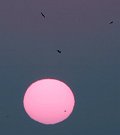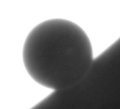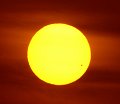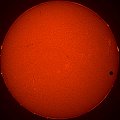|
Summary:
Every 120 years or so a dark spot glides across the
Sun. Small, inky-black, almost perfectly circular,
it's no ordinary sunspot. Not everyone can see it,
but some who do get the strangest feeling, of standing,
toes curled in the damp sand, on the beach of a South
Pacific isle.... Get the full
story from Science@NASA.
Page
1 | Page 2
| Page 3 |
Page 4 | Page
5 | This is Page 6
| Page 7
| Page 8
| Page 9
| Page 10
| Page 11
| Page 12
| Page 13
| Page 14
| Page 15
Unless otherwise stated, all images are copyrighted
by the photographers.
|
| |
Photographer,
Location |
Images |
Comments |
|

|
Frans
Snik,
Dutch Open Telescope, La Palma, Canary Islands
Jun. 08 |
#1 |
The
solar chromosphere is clearly visible as is the sunlight
refracted by Venus' atmosphere around the planet. |
|

|
Rick
Gens,
Peru,Illinois
Jun. 08 |
#1,
#2 |
I took this photo using a projection method with a 60mm
f15 refractor and a Kodak DX 4530 digital camera. I
used a 20mm eye piece. I am also enclosing a photo of
the sun just starting to rise above the horizon. |
|

|
Les
Marczi,
the south shores of Lake Ontario, Canada.
Jun. 08 |
#1,
#2, #3,
#4 |
As the Sun was rising in the
heavy hase, we could see Venus naked eye.... it was
amazing! I
took most of the shot's with a Takahashi Sky90II and
my Canon 10-D |
|

|
Dennis
Pang,
Hong Kong
Jun. 08 |
#1 |
This
photo shows the "ring of light"--i.e., the
sunlit atmosphere of Venus. |
|

|
Paul
Hyndman,
Grassy Hill airport, Roxbury CT
Jun. 08 |
#1,
more |
Today's
Venus transit expedition to Grassy Hill airport in Roxbury
CT was fantastic! Low lying clouds dramatically withdrew
just as the sun nudged through the tree-line, greeting
us with a spectacular naked-eye preview (Venus was huge!)
BTW, this is the first Venus transit ever seen in the
H-alpha bandwidth! Cameras clicked away for well over
an hour... I was able to grab 95 full-disk images during
the session! I've only processed one of the images so
far. The inset on the right is a cropped subsection
from the RAW image in unreduced size. |
|

|
Filipe
Alves,
Lisbon, Portugal
Jun. 08 |
movie |
This
movie was assembled with pictures taken with a Canon
300D and a 10' Newtonian reduced to 8', to capture the
visible ring of light that happened after the 3rd contact.
It was perfectly visible for some time to the naked
eye. Some frames of the movie also show hints of what
could be the ashen light on the surface of Venus |
|

|
Mike
McNamara,
The Jersey Shore, East Coast , USA
Jun. 08 |
#1 |
Pentax
67 with 400mm Lens and two 2x rear extenders. Fuji Velvia
ISO 50 cross processed as C-41. Exposure around 1/500sec
at F32. |
|

|
Riccardo
Di Nasso,
Montaione-Peccioli Pisa (Italy)
Jun. 08 |
#1,
#2 |
This
is a new digital camera Nikon D70 With Intes Micro 150mm
with a astrosolar filter and coronado H-Alpha. |
|

|
Andrew
Chatman,
Victor, NY
Jun. 08 |
#1,
#2, more |
Photos
taken using a hydrogen-alpha solar filter and a Canon
D60 digital camera. A horizon-level haze allowed naked
eye viewing of the transit at sunrise. As the sun rose
above the haze, I captured a sequence of the end of
the transit in hydrogen alpha. I was amazed at how large
the disk of venus was, I expected it to be much smaller.
|
back to spaceweather.com
|
|